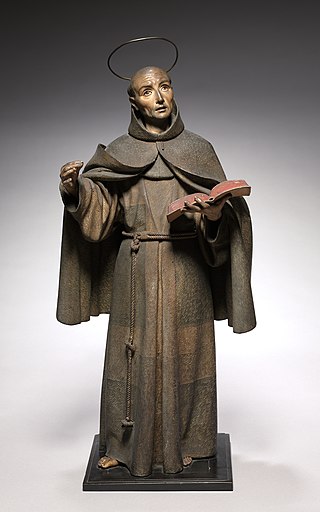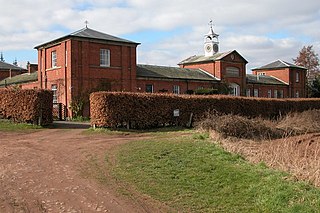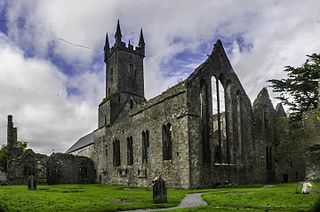Related Research Articles

The Franciscans are a group of related mendicant Christian religious orders within the Catholic Church. Founded in 1209 by the Italian saint Francis of Assisi, these orders include three independent orders for men, orders for nuns such as the Order of Saint Clare, and the Third Order of Saint Francis open to male and female members. They adhere to the teachings and spiritual disciplines of the founder and of his main associates and followers, such as Clare of Assisi, Anthony of Padua, and Elizabeth of Hungary. Several smaller Protestant Franciscan orders exist as well, notably in the Anglican and Lutheran traditions.

The Order of Friars Minor Capuchin is a religious order of Franciscan friars within the Catholic Church, one of three "First Orders" that reformed from the Franciscan Friars Minor Observant, the other being the Conventuals (OFMConv). Franciscans reformed as Capuchins in 1525 with the purpose of regaining the original Habit (Tunic) of St. Francis of Assisi and also for returning to a stricter observance of the rule established by Francis of Assisi in 1209.

Agnellus of Pisa, was an Italian Franciscan friar. As its first Minister Provincial in England (1224–1236), he is considered the founder of the Franciscans in England. His feast day is variously observed in the Catholic church on 7 May or 10 September.

The Order of Friars Minor Conventual (O.F.M.Conv.) is a male religious fraternity in the Catholic Church and a branch of the Franciscan Order. Conventual Franciscan Friars are identified by the affix O.F.M.Conv. after their names. They are also known as Conventual Franciscans or Minorites.

Peter of Alcántara, OFM was a Spanish Franciscan friar who was canonized in 1669.

The Society of Saint Francis (SSF) is an international Franciscan religious order within the Anglican Communion. It is the main recognised Anglican Franciscan order, but there are also other Franciscan orders in the Anglican Communion.
The Third Order of Saint Francis is a third order in the Franciscan tradition of Christianity, founded by the medieval Italian Catholic friar Francis of Assisi.

The Sacro Convento is a Franciscan friary in Assisi, Umbria, Italy. The friary is connected as part of three buildings to the upper and lower church of the Basilica of San Francesco d'Assisi, which contains the body of Saint Francis. St. Francis wanted to be buried at this location outside of Assisi's city walls, called Hill of Hell, because his master Jesus of Nazareth also was killed like a criminal outside of the city of Jerusalem.
The Franciscan Brothers of Brooklyn, formally known as the Congregation of the Religious Brothers of the Third Order Regular of St. Francis, were founded in Brooklyn, New York, in 1858. They have been actively involved in the education of boys and young men, primarily on Long Island, New York, serving the Diocese of Brooklyn since their founding. The Brothers of the congregation use the postnominal initials of O.S.F. Numbering 80 members as of 2008, they are the largest congregation of Religious Brothers founded in America. Formerly a diocesan congregation, in 1989, they became an Institute of Pontifical right.

The Secular Franciscan Order is the third branch of the Franciscan Family formed by Catholic men and women who seek to observe the Gospel of Jesus by following the example of Francis of Assisi. Secular Franciscans are not like the other third orders, since they are not under the higher direction of the same institute. Brothers and sisters of the Secular Franciscan Order make a spiritual commitment (promises) to their own Rule, and Secular Franciscan fraternities can not exist without the assistance of the first or second Franciscan Orders. The Secular Franciscan Order was the third of the three families founded by Francis of Assisi 800 years ago.
Angelina of Marsciano, T.O.R. was an Italian Religious Sister and foundress, and is a beata of the Roman Catholic Church. She founded a congregation of Religious Sisters of the Franciscan Third Order Regular, known today as the Franciscan Sisters of Blessed Angelina. She is generally credited with the founding of the Third Order Regular for women, as her religious congregation marked the establishment of the first Franciscan community of women living under the Rule of the Third Order Regular authorized by Pope Nicholas V.

Francis Anthony Fasani was an Italian friar of the Order of Conventual Friars Minor who has been declared a saint by the Catholic Church.
The Franciscan Portiuncula Friary is the oldest friary in Pakistan, founded in 1940. It is located in Gulshan-e-Iqbal, Karachi, adjacent to the Christ the King Seminary. It is the Pakistani base of the Order of Friars Minor, a mendicant Catholic religious order founded by Saint Francis of Assisi in 1209.

Academy of Our Lady and Spalding Institute were Catholic high schools across the street from each other in downtown Peoria, Illinois.

The Church of St. Francis of Assisi is a parish church under the authority of the Roman Catholic Archdiocese of New York, and is located at 135–139 West 31st Street, Manhattan, New York City. The parish is staffed by the Order of Friars Minor.

Pamfilo of Magliano, O.S.F., was an Italian Franciscan friar, who went to the United States in 1855 to help establish the Order there. He was responsible for the establishment of major institutions of the Order in the Northeastern United States. He founded two religious institutes of Sisters of the Third Order Regular of St. Francis.

Ennis Friary was a Franciscan friary in the town of Ennis, County Clare, Ireland. It was established in the middle of the 13th century by the ruling O'Brien dynasty who supported it for most of its existence. Following the suppression of the monasteries in the 16th century, the friary continued to function for a while despite the loss of its lands. In the early 17th century, the buildings were handed over to the Church of Ireland as a place of worship. It was used as such until the late 19th century. After the construction of a new Church of Ireland building, the friary fell into ruin. Managed by the Office of Public Works since the late 19th century, it was formally returned to the Franciscan Order in 1969.
Killarney Franciscan Friary is a monastic establishment in Killarney, County Kerry, Ireland.
References
- 1 2 3 4 5 6 "Third Order Regular of Saint Francis (T.O.R.)".
- ↑ Muscat, Noel ofm. "History of the Franciscan movement", FIOR (Franciscan Institute Outreach - Malta)
- ↑ Robinson, Paschal. "Franciscan Order." The Catholic Encyclopedia Vol. 6. New York: Robert Appleton Company, 1909. 17 June 2016
- ↑ Quinn, Pat T.O.R., "TOR History", Franciscan Friars TOR, Province of Immaculate Conception
- ↑ Franciscans Third Order Regular - Rome
- ↑ Quinn, Patrick TOR. "The Third Order Regular of St. Francis in Ireland", 1992 Archived 2013-04-10 at archive.today
- ↑ Higgins, Michael T.O.R., ""Our History", Franciscan Brothers of Brooklyn
- ↑ Conley, Seraphin TOR, "TOR & The Irish Connection in Ireland", The Cord, 1992 Archived 2013-04-10 at archive.today
- ↑ Franciscan Brothers Mountbellew
- 1 2 3
 This article incorporates text from a publication now in the public domain : Herbermann, Charles, ed. (1913). "Third Orders". Catholic Encyclopedia . New York: Robert Appleton Company.
This article incorporates text from a publication now in the public domain : Herbermann, Charles, ed. (1913). "Third Orders". Catholic Encyclopedia . New York: Robert Appleton Company. - ↑ "History", Sacred Heart Province
- ↑ "Franciscan TOR - Philippines". Franciscan TOR - Philippines. Retrieved 2017-02-10.
